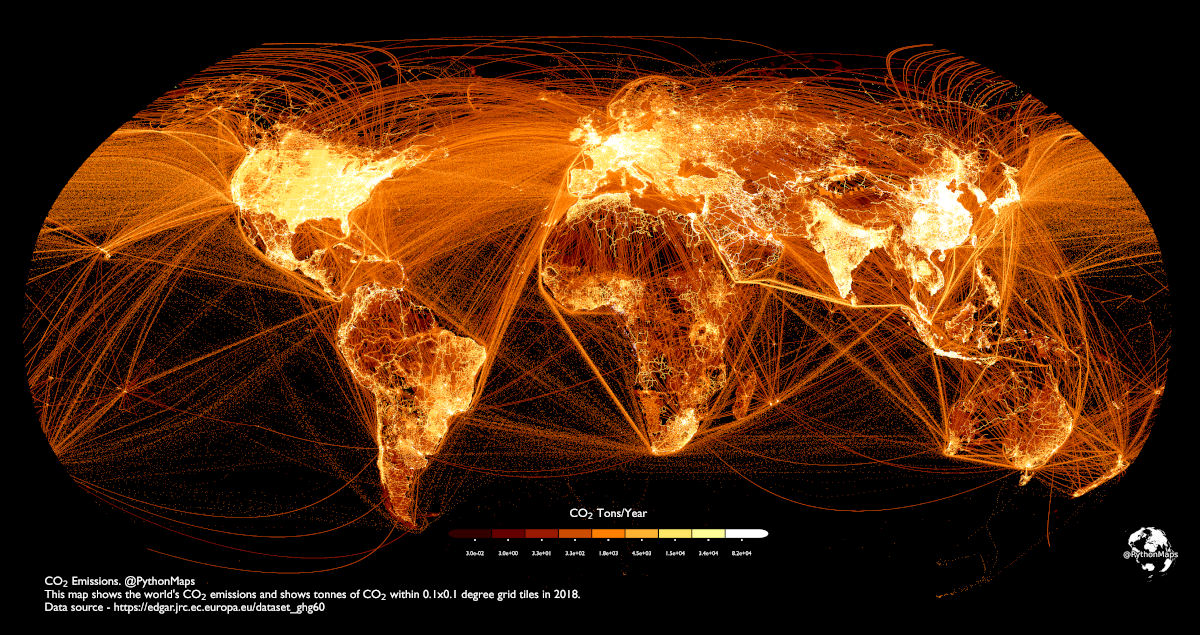
Visualizing the climate crisis helps us face the daunting reality that our global population on the planet emits approximately 34 billion tonnes of carbon dioxide (CO₂) annually. But where does this colossal volume of CO₂ originate? With the help of a graphic crafted by Adam Symington and data sourced from the European Commission, we can visually explore carbon emissions on a global scale. This graphic not only highlights population centers but also unveils flight paths, shipping lanes, and high-production regions. As we embark on this journey, we will also delve into Sylvera's Carbon Quantification Initiative and its vital role in our quest for a net-zero future.
Understanding Carbon Emissions: A Global Perspective
The visualization presented here is a stark reminder of the worldwide scope of carbon emissions. It provides an overview of CO₂ output across the globe, breaking it down into 0.1-degree grid cells, each representing roughly 11 square kilometers. This approach allows us to pinpoint not just the sources of emissions but also their density and distribution.
Population Centers: The graphic showcases major population centers as clusters of emissions, underscoring the impact of urbanization and industrialization on CO₂ output.
Flight Paths: The intricate web of flight paths crisscrossing the globe is illuminated with emissions data, emphasizing the role of air travel in our carbon footprint.
Shipping Lanes: Shipping routes are delineated by emissions data, shedding light on the carbon impact of global trade and maritime transportation.
High Production Areas: Regions with high levels of industrial production stand out prominently, revealing the connection between manufacturing and CO₂ emissions.
Paving the Way for a Net Zero Future
Sylvera's Carbon Data and Quantification Initiative seeks to quantify what we sequester in nature.
Amidst the challenges posed by escalating carbon emissions, Sylvera's Carbon Quantification Initiative emerges as a new approach. This groundbreaking initiative combines cutting-edge technology with extensive field research to revolutionize our understanding of carbon dynamics, particularly in forest ecosystems. this facilitates measuring what we sequester accurately to create a strong carbon market framework to help us restore systems with carbon credits.
Advanced Remote Sensing: Sylvera leverages state-of-the-art remote sensing techniques, including satellite imagery and drones, to gather precise data on carbon sink and flux in forests. This enables a comprehensive understanding of nature's role in carbon sequestration.
Machine Learning Algorithms: The initiative employs machine learning algorithms to analyze vast datasets efficiently, identifying trends and anomalies with unparalleled accuracy.
Global Impact: By conducting research on a global scale, Sylvera provides invaluable insights into carbon dynamics across diverse ecosystems. This information empowers policymakers, investors, and conservationists to make informed decisions.
Sylvera's work extends beyond data collection; it has the potential to transform global climate policy and catalyze investments in carbon sequestration projects.
Policy Insights: The initiative's real-time and precise data supports governments and organizations in crafting effective climate policies and strategies.
Investment Opportunities: In an era of expanding carbon markets, Sylvera's data identifies promising areas for carbon sequestration projects, attracting essential capital for climate action.
International Collaboration: Sylvera's global approach fosters international collaboration on climate initiatives, expediting progress toward a net-zero future.
As we confront the formidable challenge of climate change, visualizing global carbon emissions through initiatives like Adam Symington's graphic provides us with invaluable insights. Moreover, Sylvera's Carbon Quantification Initiative exemplifies our commitment to combating climate change, offering not only data-driven solutions but also a path towards a sustainable and resilient future. In our collective pursuit of net-zero emissions, such endeavors illuminate the way forward, reminding us that, together, we can turn the tide on climate change and protect our planet for generations to come.